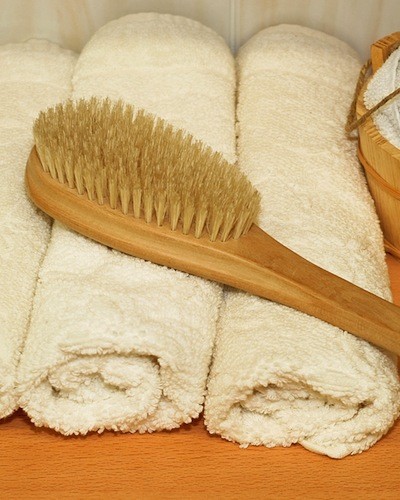4 Cheap and Easy Ways to Protect Against Swimming Pool Chemicals
With the promise of hot summer days just around the corner,
talking about the health risks of swimming pool chemicals is just a buzz
kill.
So bear with me for a moment while I mention that aside from red
eyes, dry itchy skin, and green hair, swimming in chlorinated water has
been linked to quite a list of serious ailments. According to Joseph Mercola:Your body absorbs more chlorine, and more importantly disinfection byproducts (DBPs) [such as chloramine], by swimming in a chlorinated pool than you would by drinking tap water for one week. Disinfection byproducts are far more serious than chlorine. They form when the chlorine in your pool water reacts with organic matter such as skin and hair.Growing up, we spent every summer day at the local pool from the time it opened til they ran the bell at sundown. We usually got out of the water only for snacks from the refreshment stand. By the time I was twelve, I was swimming competitively year round, spending anywhere from two to four hours doing laps in indoor pools. I distinctly remember days when my lungs ached from breathing chlorine fumes.
While swimming pool chemicals haven’t killed me, I can certainly list numerous symptoms (acne, PMS, and a chronic tendency toward candida) that might have been better sans chlorine (and my crappy SAD diet growing up).
3 health problems linked to swimming pool chemicals:
- Hormone disruption – Swimming in indoor pools for as little as 30 minutes every two weeks may result in altered hormone levels in boys. (source)
- Asthma and allergies – This study showed that swimming in chlorinated pools increased the likelihood of asthma and allergies in kids. Pool workers may also have a 40% increased risk of respiratory disorders. (source)
- Gut flora imbalance – The chlorine in our drinking and bath water can destroy beneficial bacteria in our digestive tract leading to an array of complaints from tummy problems to psychological imbalances. (source)
Though it’s only a hour or so per week in the pool, I’ve felt a little pang of guilt sending him off to to soak in chemicals. So I did some digging, and discovered there are a few cheap and cheerful methods to reduce the negative effects of chlorine and other swimming chemicals on my kids’ health.
How to protect against swimming pool chemicals:
#1 – Swim outdoors.
If you have the option, I would absolutely opt for swimming in outdoor pools as most of the issues with swimming pool chemicals seem to result from extended periods of indoor exposure where the chlorine hovers just above the water with nowhere to vent.Indoor swimming can cause more respiratory and digestive distress than open air swimming pools, and every nearly every study I found with adverse affects from chlorine were associated with indoor pools.
Better still, if you can find an outdoor pool that uses salt water, UV, or ionization – far less chlorine and other chemicals are required to maintain a pool, resulting in less chemical exposure for swimmers.
NOTE: bromine is no safer than chlorine for water purification.
#2 – Rinse before swimming.
Don’t tell anyone, but I’ve always ignored those signs that say you have to rinse before entering the pool. Those were intended for other, dirtier folks than I – the ones drenched in nasty body products, and what-not.Turns out, rinsing off before swimming, may actually help to protect against absorbing nasty pool chemicals. Some folks claim that our skin and hair are like a sponge, so saturating with clean water will prevent your body from absorbing the chlorinated stuff.
More importantly, a dangerous chemical compound call chloramine forms when chlorine reacts with ammonia from sweat. Showering before swimming can remove excess sweat that interacts with chlorine, reducing formation of chloramine on the skin.
(While you’re in the locker room, you may want to pee too, since this toxic compound also forms when chlorine comes in contact with ammonia from urine – another good reason NOT to pee in the pool!) (source)
#3 – Slather on Coconut Oil
Healthy skin is covered in a very thin, slightly acidic film called the “acid mantle” that is secreted from the skin’s sebaceous (oil) glands. The pH of bacteria, viruses, and other chemicals are primarily alkaline in nature, so the acid mantle acts as both a physical and chemical barrier to bacteria, viruses, and other potential contaminants from penetrating the skin.When we bathe with soap or swim in chlorinated water, the acid mantle is stripped away. Even when conventional lotions are applied, the skin remains too alkaline – leaving the skin and body vulnerable to invasion from harmful chemicals and pathogens. (source)
By slathering coconut oil or another natural emollient on your skin and hair before swimming your skin gets an extra layer of protection. Like your skin’s acid mantle, the coconut oil is slightly acidic and oily.
Personally, I like to use my whipped body butter which is a scrumptious combination of cocoa butter, coconut oil, and jojoba oils.
As an extra bonus, coconut oil acts as a safe and natural sunscreen – offering mild protection against the sun’s rays that are magnified when in water. (source) You can read more about taking a balanced approach to sun exposure here.
#4 – Neutralize chlorine with topical vitamin C
This was a really cool new thing I learned: the chemical structure of vitamin C (ascorbic acid) neutralizes chlorine and chloramine. (source)If the water in your home contains either of these harmful chemicals, you can purchase a fairly inexpensive vitamin C shower head that will remove up to 99% of both chlorine and chloramine. Bathing in hot water will exaggerate the risks because the chemicals can be inhaled with the steam.
When it comes to swimming, you can simply make a spray bottle with a 1 teaspoon of powdered vitamin C (like this one) dissolved in two cups filtered water. If you don’t have the time or motivation to make your own vitamin C solution, you can buy a topical spray online that will do the same job.
After swimming, spray both hair and skin with the vitamin C solution, rub in, and rinse in the shower (preferably one without chlorinated water). Finally, apply some more coconut oil to help naturally replace the body’s acid mantle, and you’re good to go!
Now, there’s no reason to ruin summer fun by steering clear of swimming pools! WOO HOO!





















